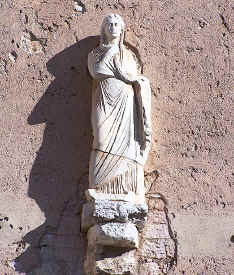|
The city gate named Porta Consolare dates from the era of the Triumvirate and the Augustan
Age. The upper portion of the triple archway construction is decorated with three statues dating from the Republican Age or from the Julius-Claudius era. The statues were originally located in the proximity of the amphitheatre.

The Cappella Tega, a 14 C chapel, is embellished with 14 C eighteen frescoes by the Umbrian school, among which a Crucifixion attributed to Alunno.
The Church of S. Maria Maggiore dates from the 13 - 17 C. The
Church is built on the ruins of a temple consecrated to the Roman goddesses Juno and
Vesta, and is rightly famous for the Baglioni Chapel adorned with frescoes in 1501 by Bernardino di Betto, better known as
Pinturicchio.
From the adjacent Palazzo dei Canonici access is gained to the Pinacotheca with its rich collection of works dating from the
13 C, 14 C, and 16 C.
The 13 C Church of S. Andrea contains 15 C frescoes by the Foligno school, a ruined
13 C fresco, an oil-painting on wood of the Crucifix from the time of Giotto, and an oil-painting on wood by
Pinturicchio.
Porta Venere dates from the Augustan Age. The triple archway construction is flanked by
twelve-sided towers known as the Torri di Properzio.
The Palazzo Comunale Vecchio was built by Maestro Prode in 1270; a 15 C fountain graces the approach. An archaeological exhibit is displayed in the main hall. A public library and archives are housed in the palazzo.
The Church of S. Lorenzo dating from 1120 has undergone numerous reworkings, the most extensive of which in the
16 C and 17 C. The Chapel of the Sacramento has a marble tabernacle by Flaminio Vacca dating from the late-16
C. The church also contains an inlaid wood choir dating from 1533 and a
17 C wooden manger.
The Arco di Augusto is an archway dating from the time of the Triumvirate and Augustan Age.
The Church and Monastery of S. Maria di Vallegloria form a complex begun in
1320. They house
16 C and 17 C frescoes and a 1560 cloister.
The Arco dei Cappuccini, also known as Porta dell'Arce is a ruin predating the Augustan Age.
The Augustan Age Porta Urbica is an imposing example of pure architectural lines.
The Roman Amphitheatre dates from the first century AD. It was part of a grand complex used for public performances and religious celebrations. All that remains are ruins of the ellipse.
The Church of S. Claudio is an example of Romanesque architecture dating from the 12C. The interior is enriched by numerous
14 C and 15 C frescoes by the Orvieto and Umbrian school.
Further on is Villa Fidelia with a formal garden in the Italian style.
The villa, originally built in the
15 C, underwent modifications in the 18 C and 19 C.
The Church and Monastery of S. Girolamo has a portico with frescoes by the Umbrian school dating from the
15 C and 16 C. The complex is located dose to a cemetery.
|
